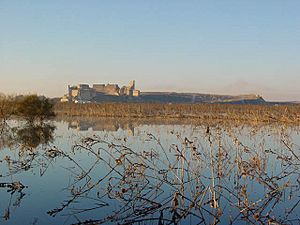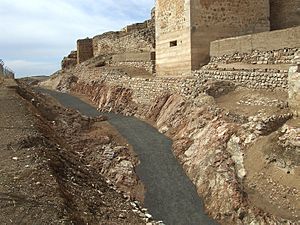Calatrava la Vieja facts for kids
Calatrava la Vieja (which means "Old Calatrava") is an important historical site from the Middle Ages in Spain. It was the first home of a famous group of warrior monks called the Order of Calatrava. Today, it is an archaeological park in the region of Castile-La Mancha.
Located near a town called Carrión de Calatrava, Calatrava was once the only major city in the Guadiana River valley during the High Middle Ages. This made it a very important place for guarding the roads to big cities like Cordova and Toledo.
Contents
What's in a Name?
The name "Calatrava" comes from an Arab phrase, Arabic: قلعة رباح, romanized: Qalʿat Rabāḥ, lit. 'Fortress of Rabah'. This refers to an Arab nobleman named Rabah who controlled the area in the 8th century. However, the site might have been a fortress even earlier, possibly built by the Iberians.
Early History of Calatrava
People started mentioning Calatrava in writings as early as 785. In 853, there were fights between the Muslims in Toledo and the emirate of Cordova. Calatrava was partly destroyed during these conflicts but was later rebuilt.
The site was rebuilt under a ruler named al-Hakam, who was the brother of Muhammad I. Calatrava then became the main city of its region. When the powerful Caliphate of Cordova fell apart, different smaller kingdoms, called Taifas, like those from Seville, Cordova, and Toledo, all wanted to control Calatrava.
Christian Conquest and the Knights Templar
In 1085, Alfonso VI of Castile conquered Toledo. A year later, a group called the Almoravids arrived in the Iberian Peninsula.
Then, in 1147, King Alfonso VII conquered Calatrava. At this time, Calatrava became one of the furthest Christian outposts during the period known as the reconquista, which was a long series of wars to reclaim land from Muslim rule.
The castle was first given to the Knights Templar to protect, but they couldn't defend it well enough. So, King Sancho III of Castile made a special offer: he would give the town and fortress of Calatrava to anyone who promised to defend it from the Moors (Muslims).
The Birth of the Order of Calatrava
A friar (a type of monk) named Diego Velásquez, who used to be a warrior, encouraged Saint Raymond of Fitero to accept the king's challenge. King Sancho gave them the right to defend Calatrava.
Raymond organized an army with help from Juan II of Toledo, the Archbishop of Toledo. In 1158, this army successfully stopped the Moors from attacking Calatrava. Because of this success, Raymond decided to create a new group of warrior monks, the Order of Calatrava. This order was organized in a similar way to the Cistercian monks.
Later Battles and Moving On
In 1195, the city was taken back by the Almohads after they won a big battle against Alfonso VIII at the Battle of Alarcos. They held Calatrava for 17 years.
In 1212, Calatrava was recovered by Christian forces as part of the campaign that led to the very important Battle of Las Navas de Tolosa. After conquering Calatrava, there were some disagreements among the Christian armies. Knights from France and other parts of Europe were not used to the summer heat. More importantly, they disagreed with King Alfonso VIII's order to treat Jews and Muslims humanely. These knights had caused problems in Toledo, where the armies had gathered, by attacking and murdering people in the Jewish Quarter. Because of these issues, more than 30,000 men left the campaign and went back home.
In 1217, the Order of Calatrava moved to a new castle called Calatrava la Nueva, about 60 kilometers to the south. This is why the original site became known as "Calatrava la Vieja" ("Old Calatrava").
Calatrava la Vieja remained an important part of the royal lands, but it was completely abandoned by the early 1400s. At that time, the leader of the Order of Calatrava moved his home to Carrión de Calatrava.
See also
 In Spanish: Calatrava la Vieja para niños
In Spanish: Calatrava la Vieja para niños



